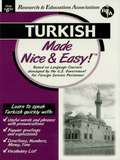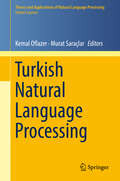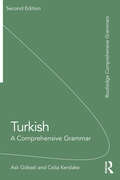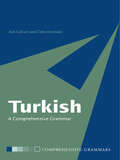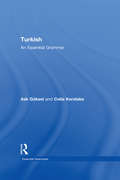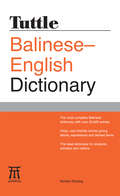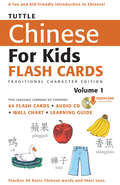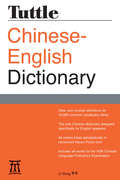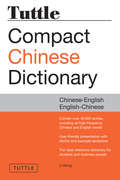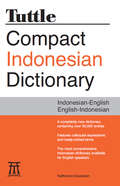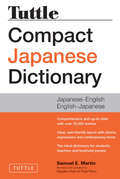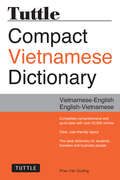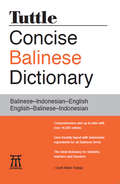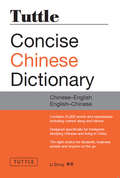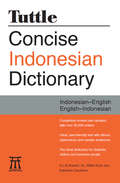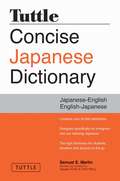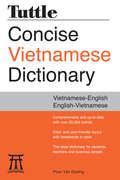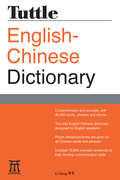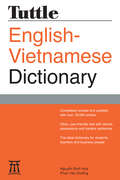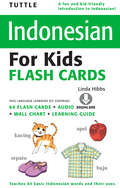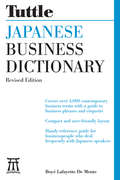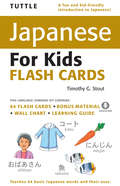- Table View
- List View
Turkish Made Nice & Easy
by The Editors of REAWhether travelling to a foreign country or to your favorite international restaurant, this Nice & Easy guide gives you just enough of the language to get around and be understood. Much of the material in this book was developed for government personnel who are often assigned to a foreign country on a moment's notice and need a quick introduction to the language.
Turkish Natural Language Processing (Theory and Applications of Natural Language Processing)
by Kemal Oflazer Murat SaraçlarThis book brings together work on Turkish natural language and speech processing over the last 25 years, covering numerous fundamental tasks ranging from morphological processing and language modeling, to full-fledged deep parsing and machine translation, as well as computational resources developed along the way to enable most of this work. Owing to its complex morphology and free constituent order, Turkish has proved to be a fascinating language for natural language and speech processing research and applications.After an overview of the aspects of Turkish that make it challenging for natural language and speech processing tasks, this book discusses in detail the main tasks and applications of Turkish natural language and speech processing. A compendium of the work on Turkish natural language and speech processing, it is a valuable reference for new researchers considering computational work on Turkish, as well as a one-stop resource for commercial and research institutions planning to develop applications for Turkish. It also serves as a blueprint for similar work on other Turkic languages such as Azeri, Turkmen and Uzbek.
Turkish: A Comprehensive Grammar (Routledge Comprehensive Grammars)
by Celia Kerslake Aslı GökselTurkish: A Comprehensive Grammar has been extensively revised in this second edition to provide a complete reference guide to modern Turkish grammar, presenting an accessible description of the language with a thorough description of the sound system, intonation patterns, word structure and sentence structure of Turkish.The book presents a stimulating analysis of the complexities of the language through detailed descriptions and illustrative examples. Relevant parts of the examples are highlighted for better understanding and are accompanied by grammatical glosses that will facilitate the parsing of the constructions. An extensive system of cross-referencing makes it easy for the reader to see the connection between topics.The book is designed as a source for intermediate and advanced learners and users of Turkish and for students of linguistics. It can be used as a reference book and supplementary material in colleges, universities, and continuing education classes, both in Turkish courses and specialized linguistics classes.
Turkish: A Step-by-step Approach For Chemical Engineers (Routledge Comprehensive Grammars)
by Celia Kerslake Aslı GökselTurkish: A Comprehensive Grammar is a complete reference guide to modern Turkish grammar. Concentrating on the real patterns of use in modern Turkish, it presents a detailed and systematic description of the structure of language at every level:sounds, words and sentences and will remain the standard reference work for years to come. Drawing upon a rapidly growing body of scholarly research on Turkish, this well-presented Grammar is a stimulating and up-to-date analysis of the complexities of the language, with full and clear explanations and examples throughout. A detailed index and extensive cross-referencing between numbered subsections also provides readers with easy access to the information they require. Features include: detailed treatment of common grammatical structures and parts of speech extensive use of examples, all with English translations particular attention to areas of confusion and difficulty comprehensive glossary of all grammatical terms. The Grammar is an essential reference source for intermediate and advanced learners and users of Turkish. It is ideal for use in schools, colleges, universities and adult classes of all types.
Turkish: An Essential Grammar (Routledge Essential Grammars)
by Celia Kerslake Asli GokselFirst published in 2010. Routledge is an imprint of Taylor & Francis, an informa company.
Tuttle Balinese-English Dictionary
by Norbert ShadegThe author, the late Father Norbert Shadeg (died 2006) combined all the valuable sources with his own extensive knowledge of the language, gained during the many years he lived and worked in Bali. The Tuttle Balinese-English Dictionary covers a wide range of vocabulary used for the affairs of daily life and for culturally important items and events, including many colorful idioms.The most complete Balinese dictionary with over 25,000 entriesClear, user-friendly entries giving idioms, expressions and derived termsThe ideal dictionary for students, scholars and visitors
Tuttle Chinese for Kids Flash Cards Kit Vol 1 Traditional Character
by Tuttle PublishingA fun and kid-friendly introduction to Chinese!The Tuttle Chinese for Kids Flash Cards (Traditional Character Edition) kit is an introductory language Chinese learning tool especially designed to help children from preschool through early elementary level acquire basic words, traditional Chinese characters, phrases, and sentences in Chinese in a fun and easy way.<P><P>The flashcards can be used as a learning tool in a classroom setting, at home, or anywhere that learning takes place, and can easily be taped around the room for an interactive way to learn Chinese. The set contains a total of 64 words, which all represent a range of sounds in Mandarin Chinese, organized into thematic categories, including: My Family, Colors, Numbers, Animals, Food, My Body, Clothes, and My Day. All of the words are illustrated-the pictures serve as effective visual aids to help children learn and remember each word's meaning. Words often reflect cultural objects and items and can be studied in any order. Learners may focus on one theme at a time or mix them up for a little more variety.
Tuttle Chinese-English Dictionary
by Li DongThis is an extensive and user-friendly Chinese to English dictionary.<P><P>The Tuttle Chinese-English Dictionary provides clear and accurate definitions in idiomatic English for the 18,000 most common Chinese vocabulary items (characters and compounds), including all words required for the official HSK Chinese Language Proficiency Examination used by the Chinese government as well as corporations and universities worldwide.This Chinese dictionary is designed specifically for English speakers. All entries are listed alphabetically in their romanized form using the standard Hanyu Pinyin romanization system. To ensure that the dictionary is up-to-date, recently coined terms have been included reflecting the dramatic changes taking place in Chinese society, business and education. Entries contain idiomatic expressions and detailed notes on Chinese culture, grammar and usage that are extremely useful for foreigners-a unique feature found in no other Chinese dictionary. Over 8,000 example Chinese sentences are provided showing how Chinese words are used in real-life situations. A concise guide to Chinese pronunciation, tones and grammar and lists of common character components, measure words are given at the front of the dictionary, while Chinese personal and place names are given at the back. Indexes list characters by strokes and also by radicals to enable the reader to look up characters when the pronunciation is not known. Clear and concise definitions for 18,000 common vocabulary items. The only Chinese dictionary designed specifically for English speakers. All entries listed alphabetically in romanized Hanyu Pinyin form. Includes all words for the HSK Chinese language Proficiency Examination.
Tuttle Compact Chinese Dictionary: Chinese English-English Chinese
by Li DongThis is a compact and user-friendly English-Chinese and Chinese-English dictionary. <P><P> The Tuttle Compact Chinese Dictionary is a completely new reference dictionary designed for English speakers who are learning or using Chinese as a foreign language. It contains more than 48,000 words and expressions, including all the words required for the official HSK Chinese Language Proficiency Examination. Entries are carefully selected to reflect the latest usage in the spheres of business, technology, sports and media. For each Chinese word, the pronunciation, word classes and definitions are given together with other useful information on measure words, and idiomatic expressions. Over 5,000 example sentences are provided to show how the words are used in real-life situations. All Chinese words and phrases are presented in Chinese characters and pinyin so that users can immediately pronounce the characters with ease and accuracy. A concise guide to Chinese pronunciation, tones and grammar is found at the front of the dictionary, as well as lists of common character components, and measure words. A Radical Index and Stroke Order Index are given for all Chinese words listed in the Chinese-English section of the dictionary. Contains over 48,000 entries, including all high-frequency Chinese and English words. User-friendly presentation with idioms and example sentences/li> The idea reference dictionary for students, and business people.
Tuttle Compact Indonesian Dictionary: Indonesian-English English-Indonesian
by Katherine DavidsenThis is a compact and user-friendly Indonesian to English dictionary.The Tuttle Compact Indonesian Dictionary is a totally new bidirectional dictionary which provides English speakers with the very latest and most concise definitions for all commonly-used Indonesian words and phrases, including thousands of new terms that have been created in the past several years. <P><P>It constitutes a vast improvement over all existing Indonesian dictionaries and is ideal for students, translators and teachers, as well as for use as a general reference dictionary. Covering over 30,000 words and expressions in a single compact volume, this dictionary provides detailed and in-depth treatment of all items. It includes a wide variety of new entries and collocations, cultural references, and sample sentences to illustrate precisely the meaning of each word. Comon colloquial phrases and expressions which are not easily understood are also included. Special attention is given to verb forms, which are marked transitive or intransitive, with examples given as to their correct use.Contains over 30,000 unique entries.Features colloquial expressions and newly-coined termsThe most comprehensive Indonesian dictionary available for English speakers.
Tuttle Compact Japanese Dictionary 2nd Edition
by Sayaka Khan Fred Perry Martin E. SamuelThis is a compact and user-friendly Japanese to English dictionary.The Tuttle Compact Japanese Dictionary is an updated and expanded version of Martin's Concise Japanese Dictionary, the favorite dictionary of students of Japanese for more than 30 years. A valuable reference for foreigners learning Japanese is the inclusion of declensions for common verbs at the back. The layout of the dictionary is extremely easy to use. Headwords are highlighted in color and all entries are given in Japanese script as well as their romanized equivalents. This format gives the learner a head start in mastering the important written characters of Japanese. This dictionary includes idiomatic expressions along with numerous sample sentences showing how Japanese words and expressions are correctly used in everyday contexts. A comprehensive pronunciation guide and detailed notes on Japanese grammar are also included.Comprehensive and up-to-date with over 20,000 entriesClear, user-friendly layout with idioms, expressions and sample sentencesThe ideal dictionary for students, teachers and business people
Tuttle Compact Japanese Dictionary 2nd Edition
by Sayaka Khan Fred Perry Martin E. SamuelThis is a compact and user-friendly Japanese to English dictionary.The Tuttle Compact Japanese Dictionary is an updated and expanded version of Martin's Concise Japanese Dictionary, the favorite dictionary of students of Japanese for more than 30 years. A valuable reference for foreigners learning Japanese is the inclusion of declensions for common verbs at the back. The layout of the dictionary is extremely easy to use. Headwords are highlighted in color and all entries are given in Japanese script as well as their romanized equivalents. This format gives the learner a head start in mastering the important written characters of Japanese. This dictionary includes idiomatic expressions along with numerous sample sentences showing how Japanese words and expressions are correctly used in everyday contexts. A comprehensive pronunciation guide and detailed notes on Japanese grammar are also included.Comprehensive and up-to-date with over 20,000 entriesClear, user-friendly layout with idioms, expressions and sample sentencesThe ideal dictionary for students, teachers and business people
Tuttle Compact Vietnamese Dictionary: Vietnamese-English English-Vietnamese
by Phan Van GiuongThis is a compact and user-friendly Vietnamese dictionary.The Tuttle Compact Vietnamese Dictionary is the most up-to-date and complete Vietnamese dictionary yet published. An essential tool to learn Vietnamese, it is written for English speakers and other non-native users who need to look up Vietnamese terms, and can also be used by Vietnamese speakers who are learning English. This dictionary has 25,000 entries covering all contemporary terms likely to be used in educational or business settings. The layout is user-friendly and attractive. Headwords are displayed in blue-this helps the reader to locate words quickly. Information on parts of speech, idiomatic expressions and sample sentences showing the us of the words in context are given for each entry. English pronunciations are given in the English to Vietnamese language section. A comprehensive pronunciation guide and detailed notes on Japanese grammar are also included. Completely comprehensive and up-to-date with over 25,000 entries.Contains English-Vietnamese and Vietnamese-English Clear, user-friendly layout with idioms, and sample sentences given. The ideal dictionary for students, teachers and business people.
Tuttle Concise Balinese Dictionary: Balinese–Indonesian–English English–Balinese–Indonesian
by I Gusti SutjajaThis is the most up-to-date Balinese Dictionary on the marketTuttle Concise Balinese Dictionary has both Balinese to English and English to Balinese sections. It's compact size allows for easy transport without limiting the content. <P><P>This Balinese dictionary is perfect for Balinese language students, or business people and tourists traveling to the Bali. It contains over 18,000 words and expressions, carefully selected to cover all important aspects of life and commerce in Bali. In addition, extensive information on Balinese grammar and Balinese pronunciation are included.This dictionary contains the following features:25,000 Balinese words and expressionsUp-to-date local Balinese slang and idiomsA guide to Balinese pronunciation and Balinese GrammarEnglish and Romanized Balinese scriptExtensive notes with detailed tips on usage and social contextParts of speech, common phrases and idiomatic expressionsOther dictionaries in this bestselling series you might be interested in include: Concise Indonesian Dictionary, Concise Tagalog Dictionary, and Concise Vietnamese Dictionary.
Tuttle Concise Chinese Dictionary
by Li DongThis is the most up-to-date Mandarin Chinese Dictionary on the marketTuttle Concise Chinese Dictionary has both Chinese to English and English to Chinese sections. It's compact size allows for easy transport without limiting the content. This Mandarin dictionary is perfect for Chinese language students, or business people and tourists traveling to China who wish to learn Chinese. It contains over 25,000 words and expressions (including all the required words for the official HSK Chinese Proficiency Examination), carefully selected to cover all important aspects of life and commerce in China. In addition, extensive information on Chinese grammar and Mandarin pronunciation are included.This dictionary contains the following features: 25,000 Chinese words and expressions. Chinese-English and English-Chinese sections Up-to-date local Chinese slang and idioms. A guide to Mandarin pronunciation and Chinese Grammar. An explanation of Mandarin tones and syllables. An introduction to writing Chinese and stroke order. Radical and stroke indexes for easy reference. All the Chinese vocabulary included in the HSK language examinations. Romanized forms (hanyu pinyin) including tones for accurate pronunciation. Extensive notes with detailed tips on usage and social context. Parts of speech, common phrases and idiomatic expressions.Other dictionaries in this bestselling series you might be interested in include: Concise Japanese Dictionary, Concise Korean Dictionary, and Concise Vietnamese Dictionary.
Tuttle Concise Indonesian Dictionary: Indonesian-English English-Indonesian
by Katherine Davidsen Willie Koen A. L. N. Kramer Sr.This is the most up-to-date Indonesian Dictionary on the marketTuttle Concise Indonesian Dictionary has both Indonesian to English and English to Indonesian sections. It's compact size allows for easy transport without limiting the content.<P><P> This Indonesian dictionary is perfect for Indonesian language students, or business people and tourists traveling to Indonesia. It contains over 20,000 words and expressions, carefully selected to cover all important aspects of life and commerce in Indonesia. In addition, extensive information on Indonesian grammar and Indonesian pronunciation are included.Concise Indonesian Dictionary contains the following features:25,000 Indonesian words and expressionsUp-to-date local Indonesian slang and idiomsA guide to Indonesian pronunciation and Indonesian GrammarEnglish and Indonesian ScriptExtensive notes with detailed tips on usage and social contextParts of speech, common phrases and idiomatic expressionsOther dictionaries in this bestselling series you might be interested in include: Concise Tagalog Dictionary, Concise Vietnamese Dictionary, and Concise Balinese Dictionary.
Tuttle Concise Japanese Dictionary
by Samuel E. Martin Sayaka Khan Fred PerryThis is the most up-to-date Japanese Dictionary on the marketNow with 30% more content, Tuttle Concise Japaense Dictionary allows for easy reference for both Japanese to English and English to Japanese. It's compact size allows for easy transport without limiting the content. This Japanese dictionary is perfect for Japanese language students, or business people and tourists travelling to Japan. It contains over 25,000 words and expressions, carefully selected to cover all important aspects of life and commerce in Japan. In addition, extensive information on Japanese grammar and Japanese pronunciation are included.This dictionary contains the following features:25,000 Japanese words and expressionsUp-to-date local Japanese slang and idiomsA guide to Japanese pronunciation and Japanese GrammarRomanized forms (romanji) and authentic Japanese characters (kanji) and script (kana)Extensive notes with detailed tips on usage and social contextParts of speech, common phrases and idiomatic expressionsOther dictionaries in this bestselling series you might be interested in include: Concise Chinese Dictionary and Concise Korean Dictionary.
Tuttle Concise Japanese Dictionary
by Samuel E. Martin Sayaka Khan Fred PerryThis is the most up-to-date Japanese Dictionary on the marketNow with 30% more content, Tuttle Concise Japaense Dictionary allows for easy reference for both Japanese to English and English to Japanese. It's compact size allows for easy transport without limiting the content. This Japanese dictionary is perfect for Japanese language students, or business people and tourists travelling to Japan. It contains over 25,000 words and expressions, carefully selected to cover all important aspects of life and commerce in Japan. In addition, extensive information on Japanese grammar and Japanese pronunciation are included.This dictionary contains the following features:25,000 Japanese words and expressionsUp-to-date local Japanese slang and idiomsA guide to Japanese pronunciation and Japanese GrammarRomanized forms (romanji) and authentic Japanese characters (kanji) and script (kana)Extensive notes with detailed tips on usage and social contextParts of speech, common phrases and idiomatic expressionsOther dictionaries in this bestselling series you might be interested in include: Concise Chinese Dictionary and Concise Korean Dictionary.
Tuttle Concise Japanese Dictionary
by Samuel E. Martin Sayaka Khan Fred PerryThis is the most up-to-date Japanese Dictionary on the marketNow with 30% more content, Tuttle Concise Japaense Dictionary allows for easy reference for both Japanese to English and English to Japanese. It's compact size allows for easy transport without limiting the content. This Japanese dictionary is perfect for Japanese language students, or business people and tourists travelling to Japan. It contains over 25,000 words and expressions, carefully selected to cover all important aspects of life and commerce in Japan. In addition, extensive information on Japanese grammar and Japanese pronunciation are included.This dictionary contains the following features:25,000 Japanese words and expressionsUp-to-date local Japanese slang and idiomsA guide to Japanese pronunciation and Japanese GrammarRomanized forms (romanji) and authentic Japanese characters (kanji) and script (kana)Extensive notes with detailed tips on usage and social contextParts of speech, common phrases and idiomatic expressionsOther dictionaries in this bestselling series you might be interested in include: Concise Chinese Dictionary and Concise Korean Dictionary.
Tuttle Concise Vietnamese Dictionary: Vietnamese-English English-Vietnamese
by Phan Van GiuongTuttle Concise Vietnamese Dictionary is the most up-to-date compact Vietnamese dictionary available today.<P><P>It is designed for English speakers who are studying the Vietnamese language, traveling to Vietnam, or using the language on a daily basis to interact with Vietnamese speakers. It has both Vietnamese to English and English to Vietnamese sections, with enough depth that it may also be used by Vietnamese speakers who are learning or using English. It's depth makes it a great way to learn Vietnamese.Divided into two parts-Vietnamese-English and English-Vietnamese-this concise dictionary has a total of 25,000 entries. The entries given within each section include all everyday words and expressions used in educational, cultural and tourism contexts in Vietnam today. The entries give core information about: Parts of speech of the headwords. Useful meanings, common collocations, idiomatic expressions and sample sentences. Vietnamese loanwords, many from French, list the original source word as well as alternate Vietnamese words with the same meaning. English entries provide additional information such as alternate British or American spellings, singular and plural forms, and irregular verb forms.Contemporary internet, computer and mobile phone terms are included, making this dictionary invaluable everyday use. A guide to Vietnamese pronunciation and spelling, and other grammar pointers and explanations are also included. The Tuttle Concise Vietnamese Dictionary is an compact and comprehensive tool for successful language learning.
Tuttle English-Chinese Dictionary
by Li DongThis is an extensive and user-friendly Chinese-English dictionary.The Tuttle English-Chinese Dictionary is the only English-Chinese dictionary specifically designed for English speakers who are learning the Chinese language. <P><P>It provides comprehensive, accurate and up-to-date definitions for over 40,000 words, phrases and idioms, including the latest vocabulary for business, technology, sport and the media.Concise definitions are given for each word and phrase shortening the time it takes to learn Chinese. About 10,000 example sentences with Chinese translation are provided for commonly used words, to illustrate their usage and develop effective communication skills in Chinese. These sentences are idiomatic and relevant to aspects of daily life in China today. Pinyin romanized forms are given for all Chinese words and phrases so the reader can pronounce them with ease and accuracy A concise guide to Chinese characters, pronunciation, tones and grammar along with lists of common character components and measure words are found at the front of the dictionary, while Chinese personal and place names are listed at the back. Comprehensive and accurate with 40,000 words, phrases and idioms. The only English-Chinese dictionary designed for English speakers. Pinyin romanizations are given for al Chinese words and phrases. Includes 10,000 example sentences to help develop communications skills.
Tuttle English-Vietnamese Dictionary
by Phan Van Giuong Nguyen Dinh HoaThis is the most up-to-date and complete English to Vietnamese dictionary available.It is designed primarily for the growing number of students of Vietnamese who need a good and reliable English-Vietnamese dictionary. Although it is targeted mainly at English speakers and other non-native users who need to learn Vietnamese, it can also be used by Vietnamese speakers who are learning or need to know English. Along with 18,000 enries--covering contemporary words and phrases used in educational, business and tourist settings--the attractive and user-friendly layout is organized effectively, making it easy to locate words and phrases quickly. It also includes many valuable pointers and information about the Vietnamese language. Completely revised and updated with over 18,000 entries. Clear, user-friendly text with idioms, expressions and sample sentences. The ideal dictionary for students and business people.The first edition, published as Essential English-Vietnamese Dictionary, was by Professor Nguyen Hinh Hoa and his daughter Patricia Nguyen Thi Huong. It became a classic in the teaching of Vietnamese. This edition, completely revised and updated, is the work of Professor Phan Van Giuong who was a distinguished professor in Vietnamese Studies at Victoria University, Melborne. Professor Phan, who has many years' experience teaching Vietnamese and English, is also the author of many Vietnamese teaching/learning materials and editor for several Vietnamese magazines and newspapers. He was awarded the Order of Australia Medal and the International Educator of the Year award for his outstanding contributions to teaching language and culture. Professor Phan is now retired but continues to teach on a part-time basis.
Tuttle Indonesian for Kids Flash Cards
by Linda HibbsA fun and kid-friendly introduction to Indonesian! The Tuttle Indonesian for Kids Flash Cards kit is an introductory Indonesian language learning tool especially designed to help children from preschool through early elementary level acquire basic words, phrases, and sentences in Indonesian in a fun and easy way. <P><P> The flashcards can be used as a learning tool in a classroom setting, at home, or anywhere that learning takes place, and can easily be taped around the room for an interactive learning experience. The set contains a total of 64 words organized into thematic categories, including: My Family, Colors, Numbers, Animals, Food and Drink, My Body, Clothes, and Where Are You Going? All of the words are illustrated-the pictures serve as effective visual aids to help children learn and remember each word's meaning. Words often reflect cultural objects and items and can be studied in any order. Learners may focus on one theme at a time or mix them up for a little more variety. Also included in this kit is an audio CD which provides native pronunciation of the words, and sample sentences for practice-sentences that children would use in everyday life. Songs and other activities are also included on the free audio CD. Finally, the kit also includes a wall chart featuring the front of each card for kids to review and a learning guide for teachers and/or parents with tips, activities and more! Once these 64 words are mastered and the child yearns for more, check out Tuttle's MORE Indonesian for Kids Flash Cards kit (978-0-8048-3987-7).
Tuttle Japanese Business Dictionary Revised Edition
by Boye Lafayette De MenteThis is a handy and comprehensive Japanese dictionary intended for use in a business settingNewly revised, Tuttle Japanese Business Dictionary contains over 4,00 key terms that provide the essential vocabulary for clear and productive discussions between Japanese and English speaking businesspeople. <P><P> These terms are usually used to clarify negotiating positions and to settle contract terms and conditions. Each term is listed alphabetically, with the romanized pronunciation (including the author's unique phonetic system to facilitate correct pronunciation even for those without any knowledge of the Japanese language) and the Japanese script given, followed by its English explanation. Where appropriate, example sentences are also included to demonstrate the proper usage of the terms. Useful information in the front of the book includes a section on how to use the dictionary, special language pointers, Japanese business etiquette and common Japanese expressions. Over 4,00 contemporary business terms. A guide to business phrases and etiquette. Compact and user-friendly layout. Handy reference guide for businesspeople who deal frequently with Japanese speakers.
Tuttle Japanese for Kids Flash Cards
by Timothy G. StoutA fun and kid-friendly introduction to Japanese!The Tuttle Japanese for Kids Flash Cards ebook is an introductory language learning tool especially designed to help children from preschool through early elementary level acquire basic words, phrases, and sentences in Japanese in a fun and easy way.<P><P>The flashcards can be used as a learning tool in a classroom setting, at home, or anywhere that learning takes place, and can easily be taped around the room for an interactive learning experience. The set contains a total of 64 words organized into thematic categories, including: My Family, Colors, Numbers, Animals, Food, My Body, Clothes, and My Day. All of the words are illustrated-the pictures serve as effective visual aids to help children learn and remember each word's meaning. Words often reflect cultural objects and items and can be studied in any order. Learners may focus on one theme at a time or mix them up for a little more variety.Also included in this ebook is downloadable audio which provides native pronunciation of the words, and sample sentences for practice-sentences that children would use in everyday life. Songs and other activities are also included on the free downloadable audio. Finally, the ebook also includes a wall chart featuring the front of each card for kids to review and a learning guide for teachers and/or parents with tips, activities and more!Once these 64 words are mastered and the child yearns for more, check out Tuttle's MORE Japanese for Kids Flash Cards kit (978-4-8053-0905-6).
